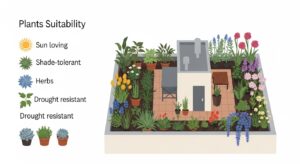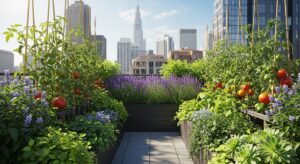In urban landscaping, rooftop gardens are becoming increasingly popular. With the surge in environmental awareness and space-conscious living, these elevated green spaces offer both beauty and function. Rooftop gardens are a powerful addition to city life, reducing heat, improving air quality, and even producing fresh herbs or vegetables. However, selecting the right plants is essential to the success of a beautiful rooftop design and garden.
This guide provides in-depth knowledge, expert-backed recommendations, and sustainable ideas. To assist you in selecting the best plants for your rooftop paradise.
Understanding the Conditions of a Rooftop Garden
Understanding the unique challenges of rooftop gardening is essential before selecting plants.
Rooftop gardens, in contrast to gardens on the ground, are subject to:
- Intense Sunlight: Rooftops frequently receive unfiltered, full sunlight, which can be harsh for many plants.
- Strong Winds: Being elevated exposes you to the wind, which can dry out and harm delicate plants.
- Heat Retention: Concrete and roofing materials absorb and radiate heat, raising ambient temperatures.
- Weight restrictions: Before adding soil, pots, and water, roofs must be checked for structural integrity. Planters and containers may only accommodate plants with shallow roots because of the shallow soil depth.
- Water Drainage: In order to avoid damage or leaks, excess water needs to drain easily.
When you are aware of these conditions, you can select plants that are not only beautiful but also resilient.
Selection Criteria for Rooftop Garden Plants
Consider the following important factors when selecting plants for rooftop gardens:
- Drought Tolerance: Select plants that are drought-tolerant and do not require daily watering.
- Compact Root Systems: Plants with shallow roots do best in raised beds and containers.
- Wind resistance: Plants that have strong stems and flexible branches are better able to withstand strong winds.
- Light Requirements: For sunny rooftops, choose full-sun lovers or shade-tolerant varieties if there is only partial shade. For year-round beauty, mix plants that bloom or display foliage color in different seasons.
- Support for Pollinators: Select flowering plants to encourage biodiversity and attract bees and butterflies.
- Native or Adapted Plants: Plants that are native or adapted tend to do better in the climate of their native area and require less upkeep.
You will create a rooftop garden that thrives with minimal effort if you check these boxes.
Best Rooftop Garden Plants
- Shrubs and perennials that love the sun:
- Lavender: This robust and fragrant plant does well in full sun and in soil.
- Rosemary is both an aromatic herb and a small shrub whose leaves can be eaten.
- Daylilies: These heat-resistant, low-maintenance perennials have vibrant blooms.
- Lantana is a plant that thrives in the sun and can withstand drought. It has vibrant flowers that entice butterflies.
- Succulents and sedums that can withstand drought.
- Sedum album is an extremely drought-tolerant groundcover.
Hardy, low-maintenance Sempervivum (Hens and Chicks) succulents are ideal for small containers. - Echeveria: Its rosette-shaped foliage adds a touch of class.
- Aloe Vera has medicinal properties and requires little water.
- Vines and Climbing Plants for Vertical Interest
- Ivy is a fast-growing, evergreen plant that looks great covering walls or trellises.
- Wisteria: This plant has dramatic blooms and flowers that trail; it needs a lot of support.
- Climbing Jasmine: With regular pruning, fragrant and manageable.
- Clematis: Provides a wide range of flower colors and thrives in containers.
- Shade-loving and foliage-rich plants,
- Hostas produce lush foliage and thrive in partial shade. Ferns are great for cooler, shaded corners because they add texture and softness
- Blue Fescue is a compact ornamental grass with foliage that is a silvery blue. With its vibrant leaves, Heuchera (Coral Bells) creates color contrast.
- Herbs and Plants for Eating:
- Cherry Tomatoes and compact varieties thrive in large pots. Peppers, whether sweet or hot, adore sunlight and heat.
Container-grown herbs include basil, oregano, thyme, mint, and parsley. Nasturtiums are edible flowers that repel pests naturally.
- Seasonal Flowers and Ornamental Grasses Miscanthus: Its tall plumes add height and movement. Calamagrostis, also known as feather reed grass, is a graceful and upright plant that excels in wind resistance. Ajuga is a groundcover that thrives in light to moderate shade. Astilbe produces fluffy, supple blooms in late spring.
How to Plan Your Rooftop Garden
Beauty, utility, and plant health are all enhanced by thoughtful design.
Examples include:
- Utilize Groupings: Plant in clusters for improved microclimate and visual impact. Mix textures and heights by planting tall grasses alongside low succulents and shrubs with mid-height.
- Seasonal planning: Select a variety of plants to maintain color and interest throughout the season.
- Choose a container that is lightweight and has good drainage. To retain some moisture, add saucers.
- Planning for irrigation: Self-watering or drip irrigation can cut down on upkeep.
- Windbreaks: To safeguard delicate plants, install trellises, railings, or bamboo screens.
Tips for Sustainability and Maintenance
Unique methods are required for rooftop gardens to be maintained:
- Soil: Use soil mixes that are light and drain well.
- Watering: In the summer, check frequently; water early in the morning or late at night.
- Controlling pests: Encourage beneficial insects and steer clear of chemical pesticides.
- Pruning: Regular pruning contributes to the health and shape of the plant.
- Composting: To recycle green waste, use small bins or vermiculture systems.
- Fire Safety: Fire-resistant options include succulents and sedums.
- Safety Check: Check the structure and railing for safety on a regular basis.
A Case Study and Advice
According to Julie Farris, a Brooklyn-based expert in rooftop gardening, “wind and weight are the biggest issues we deal with.” A neglected rooftop can become a lush oasis by selecting the appropriate plants and soil. The Rooftop Gardens project in Berlin used recycled containers and native plants to transform barren industrial rooftops into productive gardens that improved community health and sustainability. The viability and transformative power of rooftop gardening are demonstrated by these real-world examples.
Frequently Asked Questions
Q: What kinds of plants are best suited to hot rooftop gardens?
A: The best plants are drought-tolerant ones like rosemary, sedums, and lavender.
Q: Can vegetables be grown in a rooftop garden?
A: Yes, of course! For peppers, tomatoes, and herbs, use large containers or raised beds.
Q: How should I handle the wind in my rooftop garden?
A: Select wind-tolerant, flexible plants and windbreaks like lattice screens.
Q: How much room should my planters have?
A: Most vegetables and perennials thrive in soil between 10 and 14 inches deep.
Q: Is it safe to grow vegetables on a roof?
A: Yes, with an engineer’s proper structural evaluation and load calculation.
Conclusion
For rooftop gardens to be successful, it is essential to select the right plants. Your options are numerous and wonderful, including edible herbs, wind-resistant climbers, sun-loving succulents, and others. Plan for sustainability, make use of native or adaptable plants, and concentrate on the unique environment of your rooftop. Your rooftop garden will become a haven of tranquillity and joy with careful planning and selection.
Which plants have been most successful in your rooftop garden? Write about your experiences in the section below or contact us!








